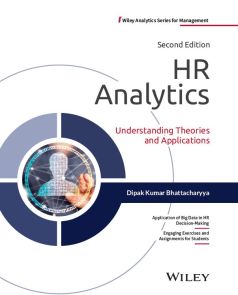HR Analytics, 2ed: Understanding Theories and Applications
ISBN: 9789357461733
242 pages
For more information write to us at: acadmktg@wiley.com

Description
HR Analytics: Understanding Theories and Applications, 2nd edition, delves deeper into the transformative world of data-driven human resource management. In an era defined by the rapid evolution of technology, it discovers the latest insights on artificial intelligence (AI) and machine learning (ML), and explores the major advances and applications of big data, providing HR professionals with the tools they need to make strategic, data-driven decisions.
Preface to the Second Edition
Preface to the First Edition
About the Author
Acknowledgements
Chapter 1 Evolution of Human Resource Management Function
1.1 Introduction
1.2 History of Different HRM Perspectives
1.3 HRM and Strategy
1.4 Reinforcement of HR Strategy Factors with HR Analytics
1.5 Human Resource Management as a Process
1.6 Human Resource Management as a System
1.7 Better Clarity on Roles of HR Managers
1.8 Transition of Human Resource Management to Human Capital Management
1.9 Sustainable Competitive Advantage through Human Capital
1.10 Emergence of Human Resource Control Systems
1.11 Measurement Tools Used in Human Resource Controlling
Chapter 2 HR Decision-Making and HR Analytics
2.1 Introduction
2.2 HR Decision-Making
2.3 Descriptive HR Decision-Making
2.4 Correlational HR Decision-Making
2.5 Predictive HR Decision-Making
2.6 Concept and Definitions of Analytics
2.7 Importance and Significance of HR Analytics
2.8 Benefits of HR Analytics
2.9 Steps to Implement HR Analytics
2.10 Critical HR Decision-Making and HR Analytics
2.11 Predictive HR Analytics
2.11.1 Benefits of Predictive Analytics
2.12 HR Analytics and Changing Role of HR Managers
Chapter 3 Introduction to HR Analytics
3.1 Introduction
3.2 Concepts and Definitions
3.3 Aligning Human Resources to Business through HR Analytics
3.4 Steps for Alignment of HR Analytics with Business Goals and Strategies
3.5 Checklists for Strategies and Business-Aligned HR Analytics
3.6 History of HR Analytics
3.7 Applications of HR and Predictive Analytics
3.8 Importance and Benefits of HR Analytics
3.9 HR Analytics Framework and Models
Chapter 4 HR Business Process and HR Analytics
4.1 Introduction
4.2 Statistics and Statistical Modelling for HR Research and HR Decision-Making
4.3 HR Research Tools and Techniques
4.4 Data Analysis for Human Resources
4.5 Parametric and Non-Parametric Tests
4.6 HRIS for HR Decision-Making
4.6.1 Objectives of HRIS
4.7 HR Metrics
4.8 Recruitment Metrics
4.9 Metrics for Training and Development Function
4.10 HR Scorecard
4.11 HR Dashboards
4.12 HR Analytics as a Better Tool for HR Decisions
4.13 Compelling Reasons for HR Analytics
Chapter 5 Forecasting and Measuring HR Value Propositions with HR Analytics
5.1 Introduction
5.2 Value Proposition and HR Decisions
5.3 Sustainability in HR Decisions
5.4 HR Analytics and HR Value Propositions
5.5 HR Optimization through HR Analytics
5.6 HR Forecasting, HR Plan and HR Analytics
5.7 Predictive HR Analytics
Chapter 6 HR Analytics and Data
6.1 Introduction
6.2 HR Data and Data Quality
6.3 HR Data Collection
6.3.1 Steps for HR Data Collection
6.4 Big Data for Human Resources
6.5 Transforming HR Data into HR Information
6.6 Process of Data Collection for HR Analytics
6.7 Data Collection for Effective HR Measurement
6.8 HR Reporting
6.9 Types and Forms of HR Reports
6.10 Data Visualization or HR Report Visualization
6.10.1 Performing Root Cause Analysis
6.11 Datafication of Human Resources
Chapter 7 HR Analytics and Predictive Modelling
7.1 Introduction
7.2 Different Phases of HR Analytics or HR Predictive Modelling
7.3 Examples of Predictive Analytics
7.4 Data and Information for HR Predictive Analysis
7.5 Software Solutions
7.6 Predictive Analytics Tools and Techniques
Chapter 8 HR Analytics for Future
8.1 Introduction
8.2 Understanding Future Human Resources
8.3 Generic Future HR Skillsets and Knowledge
8.4 Ethical Issues in HR Analytics
8.5 HR Feel More Empowered with HR Analytics
8.6 Artificial Intelligence and HR
8.7 Different Types of AI for HR Functions
8.8 AI and Machine Learning
Summary
Multiple-Choice Questions
Review Questions
Critical Review Question
Case Study
References
Appendix
Glossary
Index



